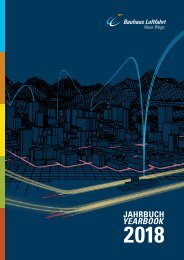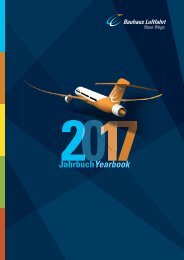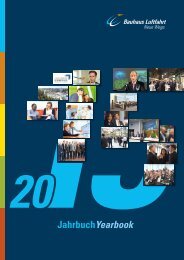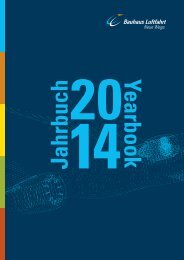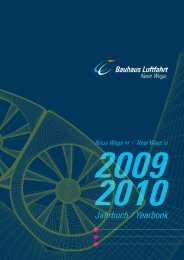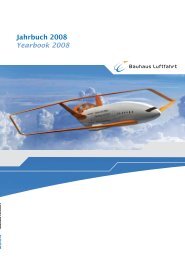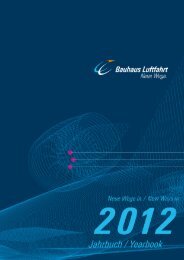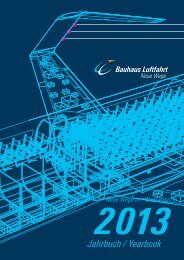Bauhaus Luftfahrt Jahrbuch 2019
- No tags were found...
You also want an ePaper? Increase the reach of your titles
YUMPU automatically turns print PDFs into web optimized ePapers that Google loves.
05
Sehr geehrte Damen und Herren
Die öffentlichen Diskussionen zum Klimaschutz im vergangenen
Jahr zeigen die Notwendigkeit von langfristigen Lösungen für
den Luftverkehr von morgen. Im Rahmen des vierten internationalen
wissenschaftlichen Symposiums haben rund 200 namhafte
Experten aus Industrie, Politik und Forschung über anderthalb
Tage radikale Technologien und Ansätze diskutiert, welche die
Klimawirkung des Luftverkehrs aktiv und vor allem positiv beeinflussen
können. Hierbei wurden die Optionen – vor dem Hintergrund
der ambitionierten Flightpath-2050-Ziele – mittels technischer,
wirtschaftlicher und regulatorischer Kriterien auf ihre
Eignung bewertet.
Ein wichtiger Bestandteil einer langfristigen Energiestrategie
für die Luftfahrt ist die Umstellung von fossilen auf erneuerbare
Kraftstoffe. Im vergangenen Jahr gelang innerhalb des Projektes
SUN-to-LIQUID erstmals die Herstellung von solarem Kerosin
aus Sonnenlicht, Wasser und CO 2 unter realen Bedingungen.
Als Projektkoordinator war das Bauhaus Luftfahrt an diesem
zukunftsweisenden Fortschritt in solarer Kraftstofftechnologie
maßgebend beteiligt. Der von der ETH Zürich entwickelte solarthermochemische
Reaktor wurde erstmalig hinsichtlich einer
industriellen Kraftstoffproduktion validiert. Die Demonstration
dieser Technologie wird große Auswirkungen auf den Transportsektor
und im Speziellen auf die Luftfahrt haben, die auf langen
Strecken weiterhin auf flüssige Kraftstoffe angewiesen bleibt.
Als Ideenschmiede und Impulsgenerator für Fachwelt,
Öffentlichkeit und Politik nimmt das Bauhaus Luftfahrt eine
wichtige Vorreiterrolle ein, unter anderem bei der Bewertung
externer Effekte auf die langfristige Entwicklung des Luftverkehrs.
Dank seiner interdisziplinären Struktur kann der Thinktank
für die Luftfahrt sowohl technologische als auch sozioökonomische
Treiber identifizieren und deren Wirkung auf
den Luftverkehr umfassend evaluieren. Eine Rolle, die gerade
heute immer wichtiger zur Identifikation von Handlungsfeldern
wird.
Das vorliegende Jahrbuch widmet sich diesen Herausforderungen
der Luftfahrt und zeigt Impulse und mögliche Handlungsoptionen
auf. Ich wünsche Ihnen viel Freude beim Lesen
dieses besonderen Jahrbuches!
Ihr
Axel Flaig
Dear Ladies and Gentlemen
The public discussions on climate protection last year
show the need for long-term solutions for tomorrow’s air
traffic. During the fourth international scientific symposium,
around 200 renowned experts from industry, politics,
and research spent one and a half days discussing
radical technologies and approaches that can actively
and, above all, positively influence the climate impact of
aviation. In doing so, the options were evaluated for their
suitability – against the background of the ambitious
goals of the Flightpath 2050 – using technical, economic,
and regulatory criteria.
An important component of a long-term energy strategy
for aviation is the transition from fossil to renewable
fuels. Last year, the SUN-to-LIQUID project succeeded in
producing the first solar kerosene from sunlight, water,
and CO 2 under real field conditions. As project coordinator,
Bauhaus Luftfahrt played a key role in this forwardlooking
breakthrough in solar fuel technology. The solarthermochemical
reactor developed by ETH Zurich was
experimentally validated for the first time with regard to
industrial fuel production. The demonstration of this technology
will have important implications for the transportation
sectors, especially for aviation, which will remain
strongly dependent on drop-in liquid fuels over long distances.
As a think tank and impulse generator for experts,
the public, and politicians, Bauhaus Luftfahrt is playing a
key pioneering role, including in the assessment of external
effects on the long-term development of air traffic.
Due to its interdisciplinary structure, the think tank is
able to identify both technological and socioeconomic
drivers for aviation as well as comprehensively evaluate
their impact on air traffic. A role that is becoming
increasingly important, especially today, in identifying
fields of action.
This Yearbook is devoted to these challenges of
aviation and shows impulses and potential options for
action. I hope you enjoy reading this special Yearbook!
Your
Axel Flaig



